Subseasonal Tidal Variability in the Gulf of Tonkin Observed by Multi-Satellite Altimeters and Tide Gauges
Abstract
:1. Introduction
2. Study Area and Data
2.1. Study Area
2.2. Data
3. Methods
3.1. Harmonic Analysis for Tide Gauges
3.2. Harmonic Analysis for Satellite Altimeters
4. Results
4.1. Subseasonal Tidal Variability from Tide Gauges
4.2. Seasonal Tidal Variability from Satellite Altimeters
4.3. Subseasonal Tidal Variability from Satellite Altimeters
5. Discussions
5.1. Causes of Subseasonal Tidal Variability
5.2. Benefits and Defects of Present Study
6. Conclusions
Author Contributions
Funding
Data Availability Statement
Code Availability Statement
Conflicts of Interest
Appendix A

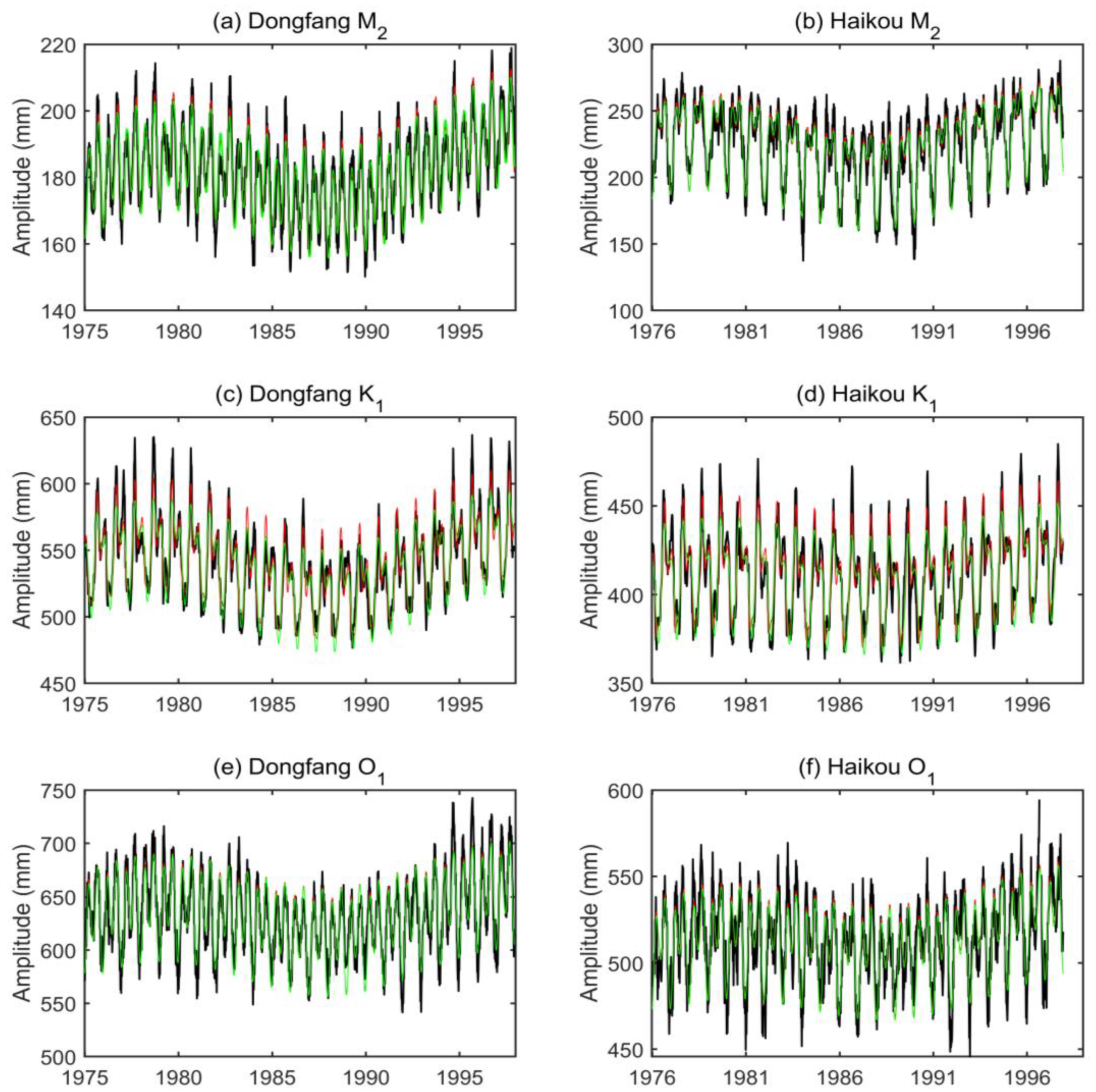
References
- Gan, M.; Pan, H.; Chen, Y.; Pan, S. Application of the Variational Mode Decomposition (VMD) Method to River Tides. Estuar. Coast. Shelf Sci. 2021, 261, 107570. [Google Scholar] [CrossRef]
- Pan, H.; Lv, X.; Wang, Y.; Matte, P.; Chen, H.; Jin, G. Exploration of Tidal-Fluvial Interaction in the Columbia River Estuary Using S_TIDE. J. Geophys. Res. Ocean. 2018, 123, 6598–6619. [Google Scholar] [CrossRef]
- Yu, Q.; Pan, H.; Gao, Y.; Lv, X. The Impact of the Mesoscale Ocean Variability on the Estimation of Tidal Harmonic Constants Based on Satellite Altimeter Data in the South China Sea. Remote Sens. 2021, 13, 2736. [Google Scholar] [CrossRef]
- Pan, H.; Guo, Z.; Lv, X. Inversion of Tidal Open Boundary Conditions of the M2 Constituent in the Bohai and Yellow Seas. J. Atmos. Ocean. Technol. 2017, 34, 1661–1672. [Google Scholar] [CrossRef]
- Wei, Z.; Pan, H.; Xu, T.; Wang, Y.; Wang, J. DevelopmentHistory of the Numerical Simulation of Tides in the East Asian Marginal Seas: An Overview. J. Mar. Sci. Eng. 2022, 10, 984. [Google Scholar] [CrossRef]
- Jay, D.A. Evolution of tidal amplitudes in the eastern Pacific Ocean. Geophys. Res. Lett. 2009, 36, L04603. [Google Scholar] [CrossRef] [Green Version]
- Ray, R.D. Secular changes in the solar semidiurnal tide of the western North Atlantic Ocean. Geophys. Res. Lett. 2009, 36, L19601. [Google Scholar] [CrossRef] [Green Version]
- Pan, H.; Zheng, Q.; Lv, X. Temporal changes in the response of the nodal modulation of the M2 tide in the Gulf of Maine. Cont. Shelf Res. 2019, 186, 13–20. [Google Scholar] [CrossRef]
- Müller, M. Rapid Change in Semi-Diurnal Tides in the North Atlantic since 1980. Geophys. Res. Lett. 2011, 38, 11. [Google Scholar] [CrossRef]
- Wang, D.; Pan, H.; Jin, G.; Lv, X. Seasonal Variation of the Principal Tidal Constituents in the Bohai Sea. Ocean Sci. 2020, 16, 1–14. [Google Scholar] [CrossRef]
- Devlin, A.T.; Zaron, E.D.; Jay, D.A.; Talke, S.A.; Pan, J. Seasonality of Tides in Southeast Asian Waters. J. Phys. Oceanogr. 2018, 48, 1169–1190. [Google Scholar] [CrossRef]
- Pan, H.; Lv, X. Is There a Quasi 60-Year Oscillation in Global Tides? Cont. Shelf Res. 2021, 222, 104433. [Google Scholar] [CrossRef]
- Kang, S.; Foreman, M.; Lie, H.; Lee, J.; Cherniawsky, J.; Yum, K. Two-layer tidal modeling of the Yellow and East China Seas with application to seasonal variability of the M2 tide. J. Geophys. Res. 2002, 107, 3020. [Google Scholar] [CrossRef] [Green Version]
- Feng, X.; Tsimplis, M.; Woodworth, P. Nodal variations and long-term changes in the main tides on the coasts of China. J. Geophys. Res. Oceans. 2015, 120, 1215–1232. [Google Scholar] [CrossRef] [Green Version]
- Pan, H.; Devlin, A.T.; Xu, T.; Lv, X.; Wei, Z. Anomalous 18.61-Year Nodal Cycles in the Gulf of Tonkin Revealed by Tide Gauges and Satellite Altimeter Records. Remote Sens. 2022, 14, 3672. [Google Scholar] [CrossRef]
- Peng, D.; Hill, E.; Meltzner, A.; Switzer, A. Tide gauge records show that the 18.61-year nodal tidal cycle can change high water levels by up to 30 cm. J. Geophys. Res. Ocean. 2019, 124, 736–749. [Google Scholar] [CrossRef] [Green Version]
- Devlin, A.; Jay, D.; Talke, S.; Zaron, E. Can tidal perturbations associated with sea level variations in the western Pacific Ocean be used to understand future effects of tidal evolution? Ocean Dyn. 2014, 64, 1093–1120. [Google Scholar] [CrossRef] [Green Version]
- Rayson, M.D.; Jones, N.L.; Ivey, G.N.; Gong, Y. A seasonal harmonic model for internal tide amplitude prediction. J. Geophys. Res. Oceans. 2021, 126, e2021JC017570. [Google Scholar] [CrossRef]
- Nguyen, N.M.; Marchesiello, P.; Lyard, F.; Ouillon, S.; Cambon, G.; Allain, D.; Dinh, U.V. Tidal characteristics of the Gulf of Tonkin. Cont. Shelf Res. 2014, 91, 37–56. [Google Scholar]
- Zavala-Garay, J.; Rogowski, P.; Wilkin, J.; Terrill, E.; Shearman, R.K.; Tran, L.H. An integral view of the Gulf of Tonkin seasonal dynamics. J. Geophys. Res. Oceans. 2022, 127, e2021JC018125. [Google Scholar] [CrossRef]
- Amante, C.; Eakins, W. ETOPO1 1 arc-minute global relief model: Procedures, data sources and analysis. In NOAA Technical Memorandum NESDIS NGDC-24; National Geophysical Data Center: Boulder, CO, USA, 2009; p. 19. [Google Scholar]
- Hart-Davis, M.; Piccioni, G.; Dettmering, D.; Schwatke, C.; Passaro, M.; Seitz, F. EOT20: A global ocean tide model from multi-mission satellite altimetry. Earth Syst. Sci. Data 2021, 13, 3869–3884. [Google Scholar] [CrossRef]
- Birol, F.; Fuller, N.; Lyard, F.; Cancet, M.; Niño, F.; Delebecque, C.; Fleury, S.; Toublanc, F.; Melet, A.; Saraceno, M.; et al. Coastal Applications from Nadir Altimetry: Example of the X-TRACK Regional Products. Adv. Space Res. 2017, 59, 936–953. [Google Scholar] [CrossRef]
- Pan, H.; Jiao, S.; Xu, T.; Lv, X.; Wei, Z. Investigation of tidal evolution in the Bohai Sea using the combination of satellite altimeter records and numerical models. Estuar. Coast. Shelf Sci. 2022, 279, 108140. [Google Scholar] [CrossRef]
- Pawlowicz, R.; Beardsley, B.; Lentz, S. Classical Tidal Harmonic Analysis with Error Analysis in MATLAB Using T_TIDE. Comput. Geosci. 2002, 28, 929–937. [Google Scholar] [CrossRef]
- Piccioni, G.; Dettmering, D.; Schwatke, C.; Passaro, M.; Seitz, F. Design and regional assessment of an empirical tidal model based on FES2014 and coastal altimetry. Adv. Space Res. 2021, 68, 1013–1022. [Google Scholar] [CrossRef]
- Taburet, G.; Sanchez-Roman, A.; Ballarotta, M.; Pujol, M.-I.; Legeais, J.-F.; Fournier, F.; Faugere, Y.; Dibarboure, G. DUACS DT2018: 25 years of reprocessed sea level altimetry products. Ocean Sci. 2019, 15, 1207–1224. [Google Scholar] [CrossRef] [Green Version]
- Zaron, E.; Ray, R. Aliased Tidal Variability in Mesoscale Sea Level Anomaly Maps. J. Atmos. Ocean. Technol. 2018, 35, 2421–2434. [Google Scholar] [CrossRef]
- Zhang, Y.; Pan, H.; Li, S.; Lv, X. Extracting Modulated Annual Cycle in Climate and Ocean Time Series Using an Enhanced Harmonic Analysis. Math. Probl. Eng. 2021, 2021, 9625795. [Google Scholar] [CrossRef]
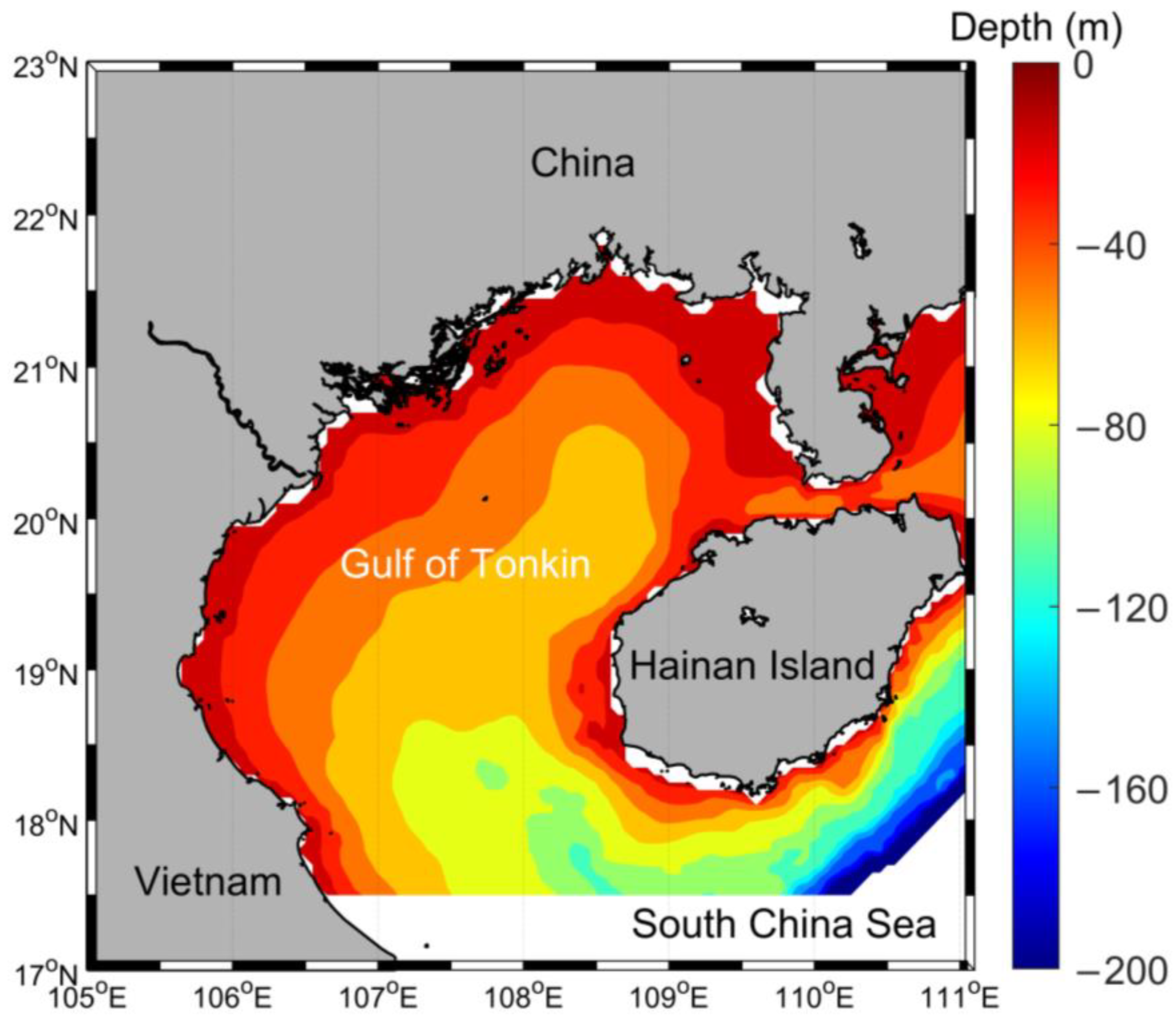
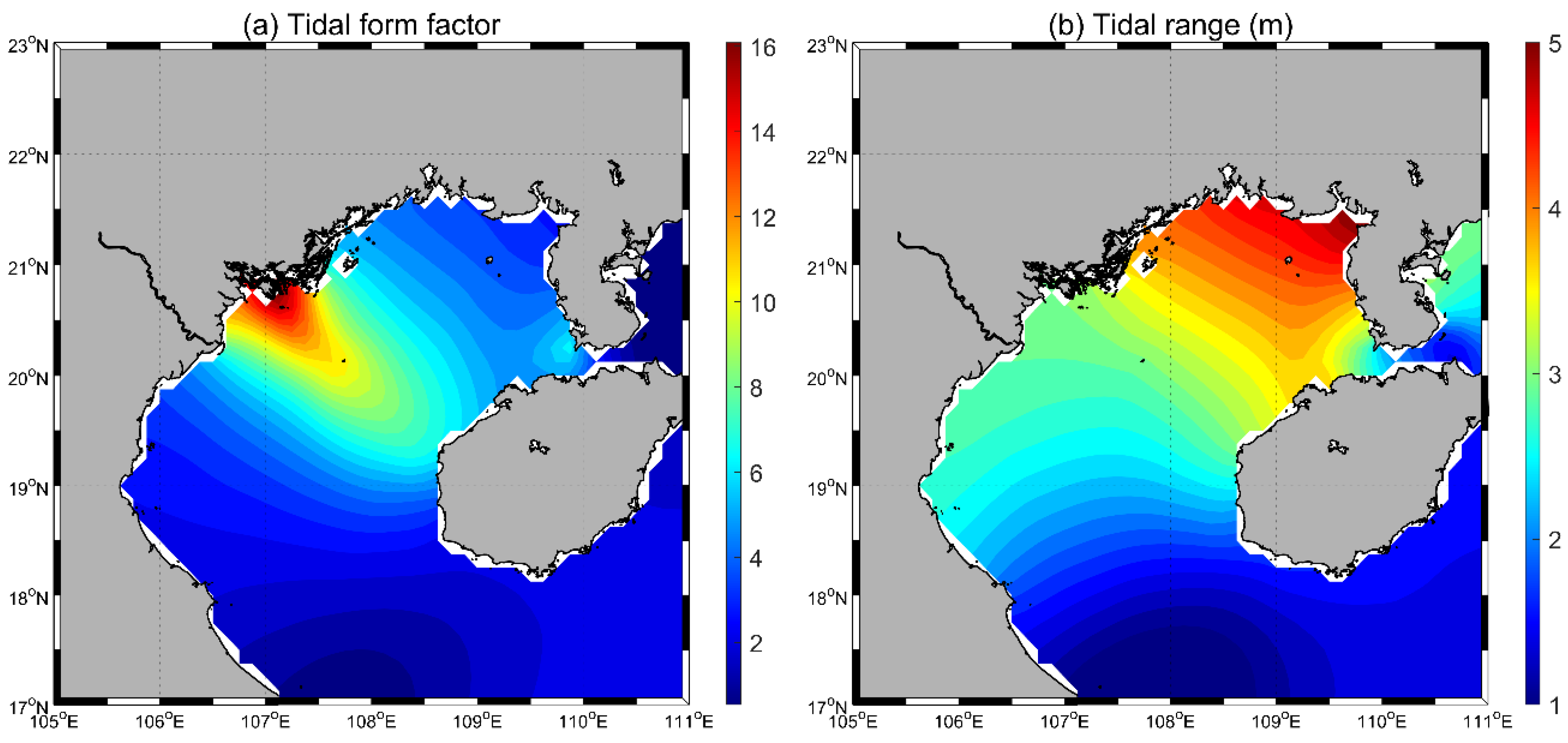
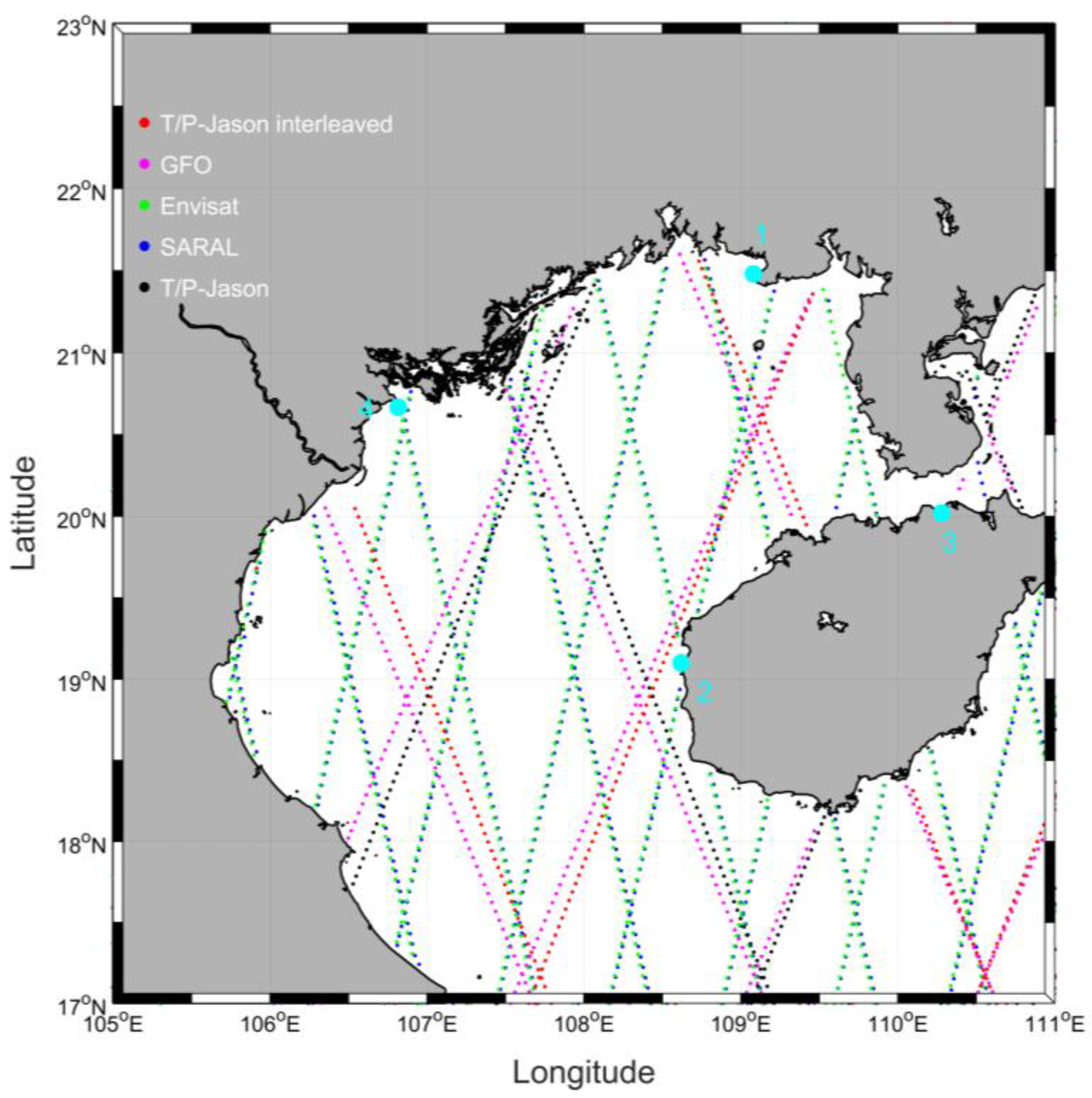
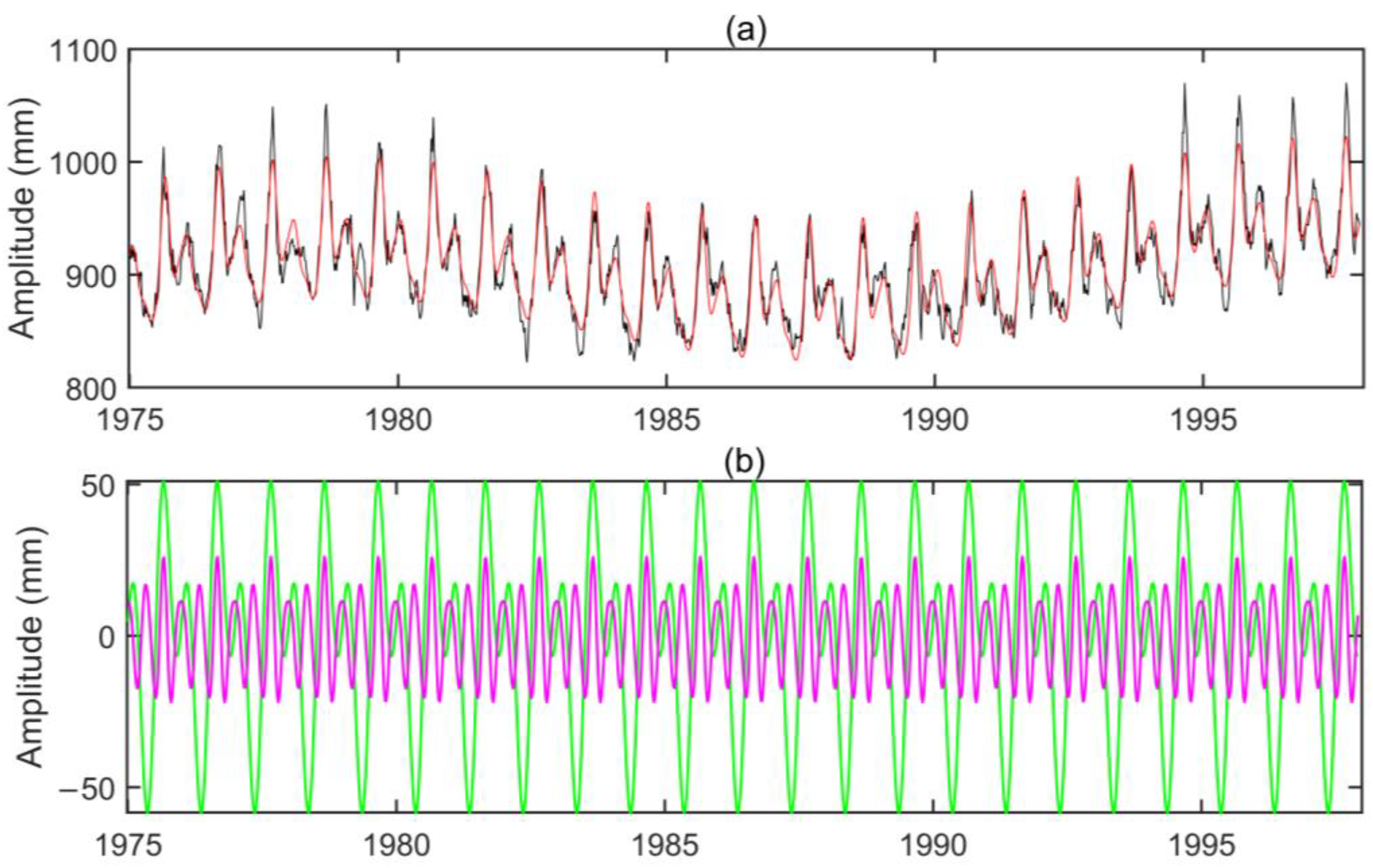


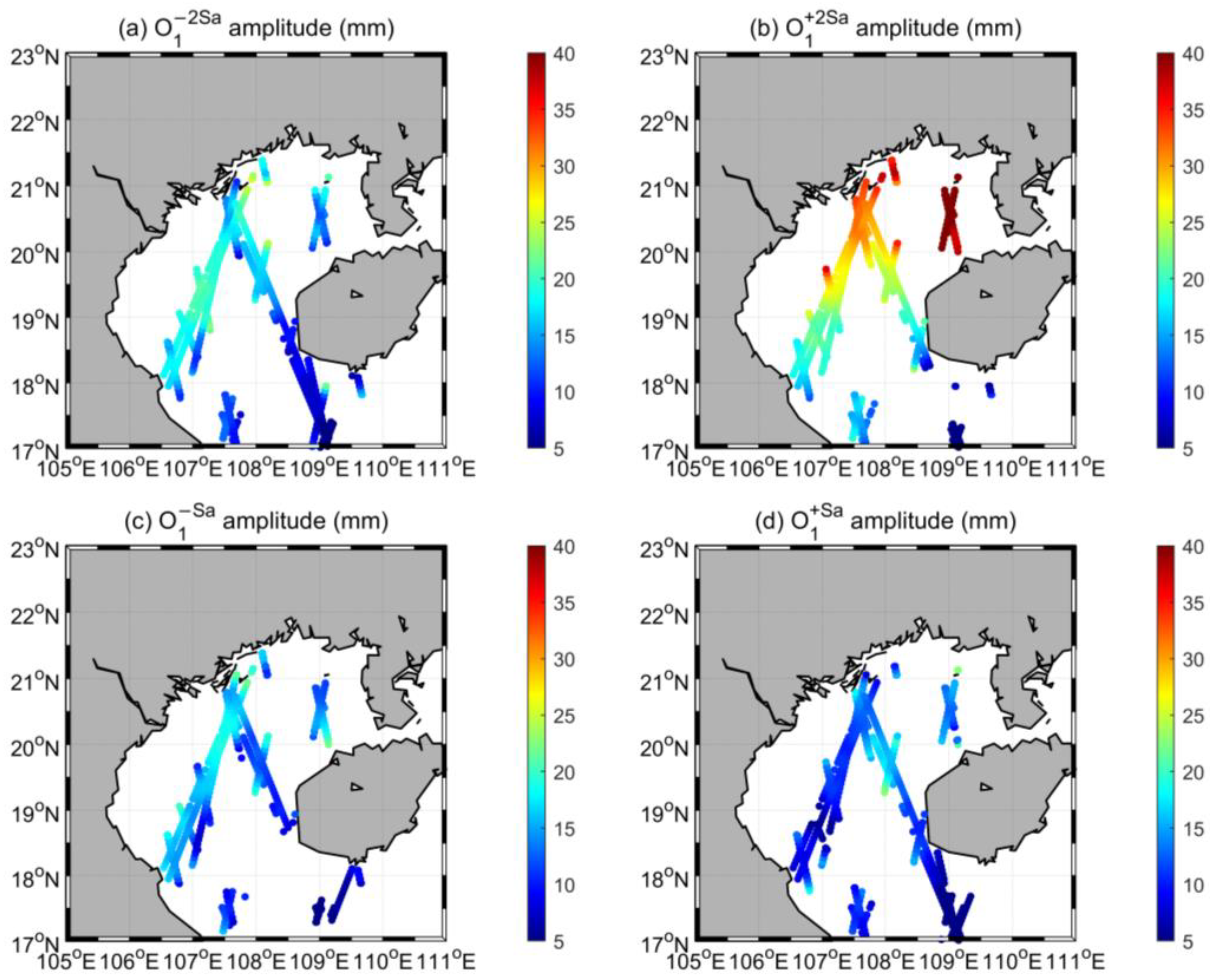
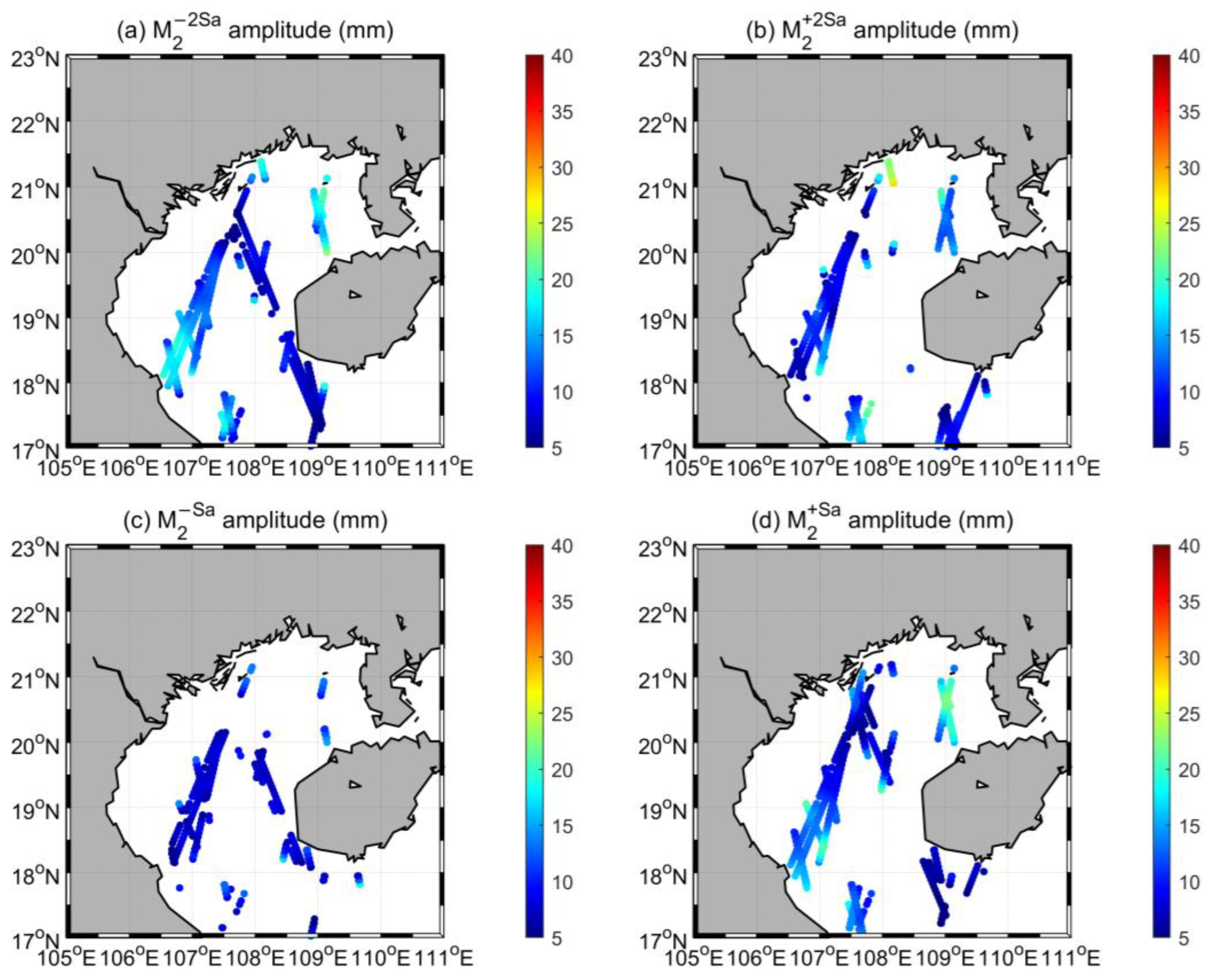
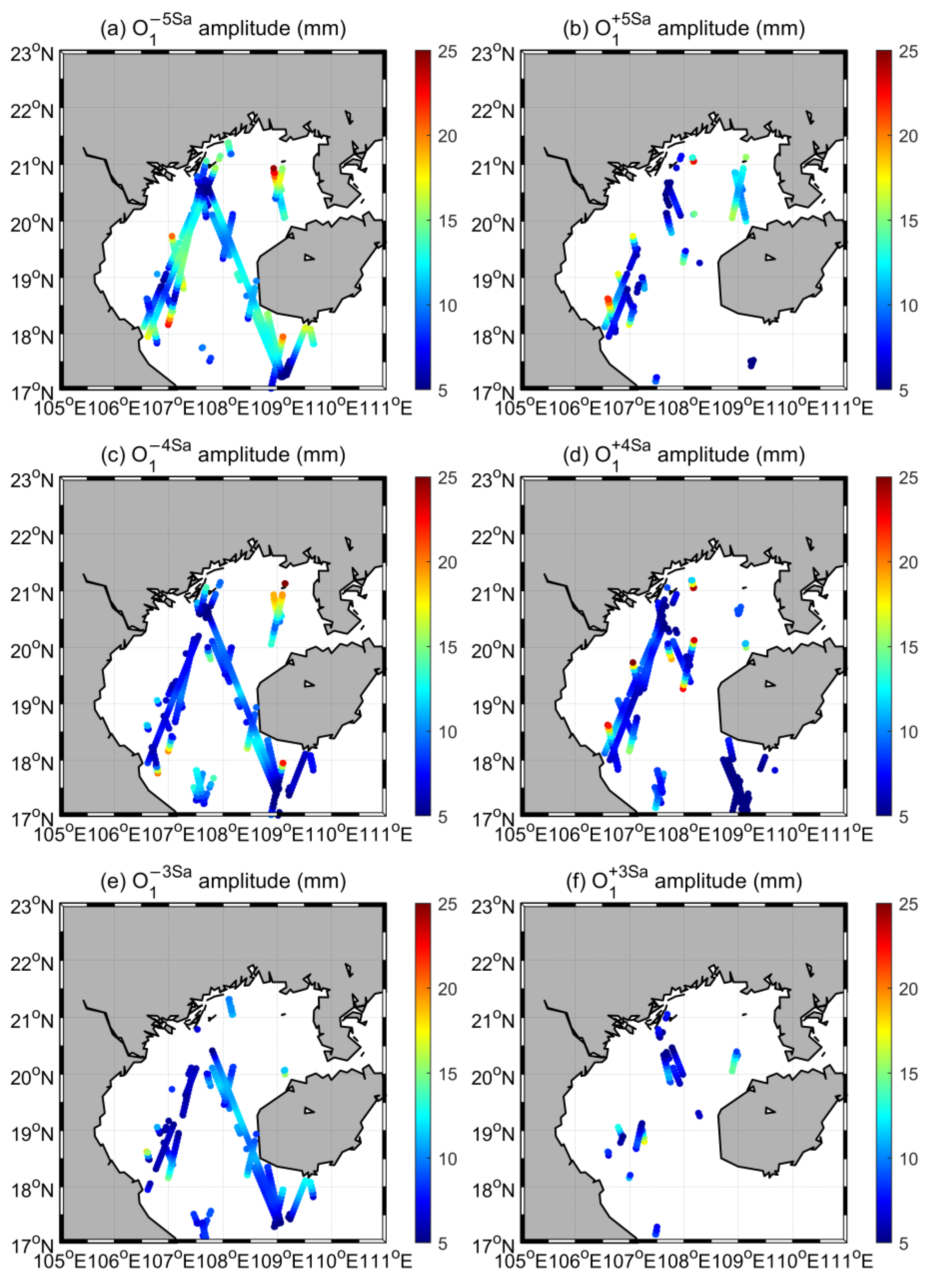
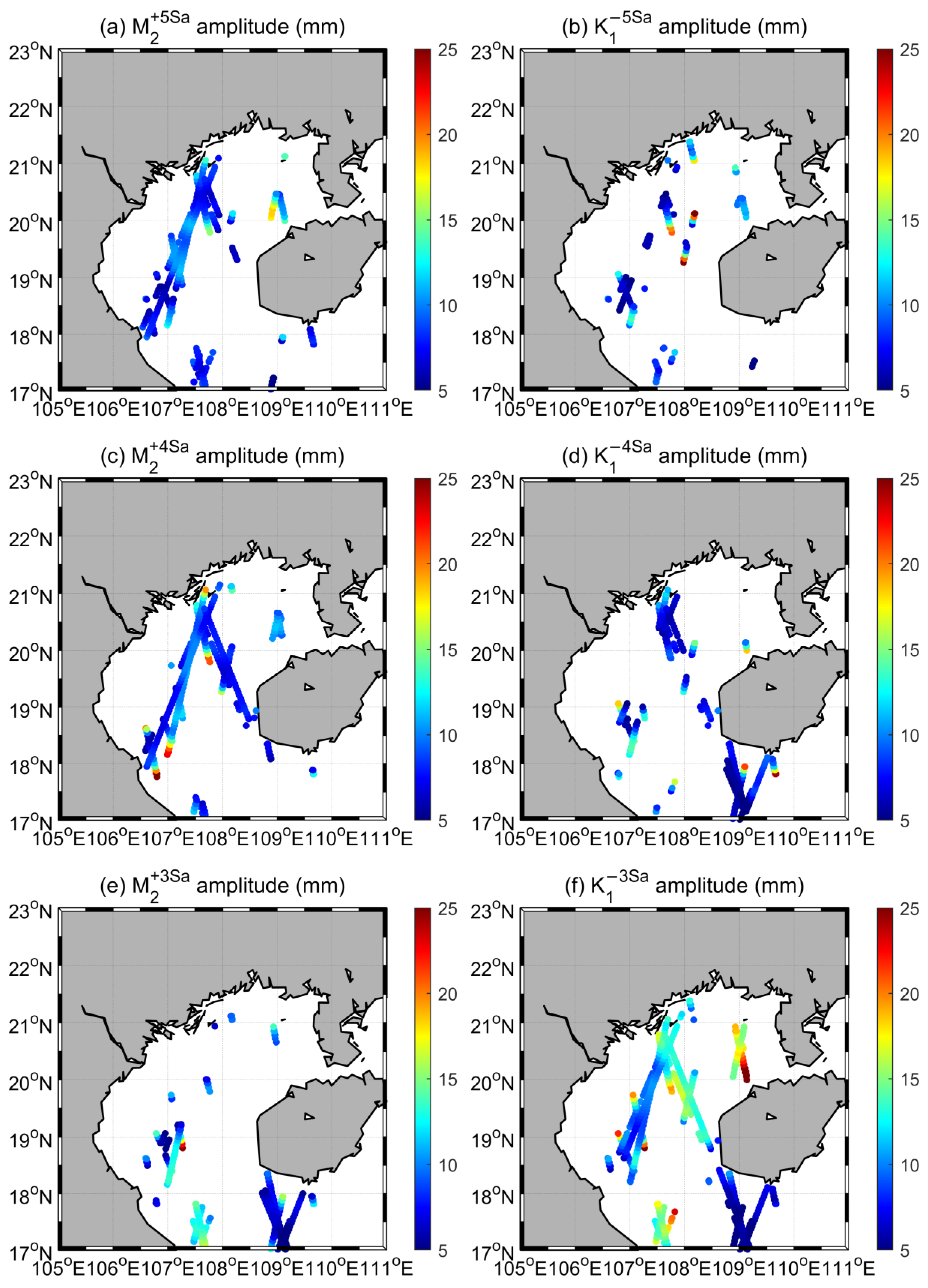

| Stations | Country | UHSLC Number | Latitude (°N) | Longitude (°E) | Time Span | Completeness (%) |
|---|---|---|---|---|---|---|
| Hondau | Vietnam | 650 | 20.67 | 106.82 | January 1960–December 1960 | 100.00 |
| Beihai | China | 636 | 21.48 | 109.08 | January 1975–December 1997 | 99.83 |
| Dongfang | China | 637 | 19.10 | 108.62 | January 1975–December 1997 | 99.98 |
| Haikou | China | 638 | 20.02 | 110.28 | January 1976–December 1997 | 99.91 |
| Mission | Start Date | End Date | Sampling Period (Days) |
|---|---|---|---|
| T/P + Jason1 + Jason2 + Jason3 | 28 February 1993 | 2 June 2020 | 9.915642 |
| Envisat | 1 October 2002 | 14 September 2010 | 35 |
| GFO | 8 January 2008 | 8 September 2008 | 17.05058 |
| T/P + Jason1 interleaved | 21 September 2002 | 2 February 2012 | 9.915642 |
| Saral/Altika | 4 March 2013 | 7 April 2016 | 35 |
| Tides | Doodson Numbers | Frequency (Hour−1) | T/P-Jason Alias Period (Days) | Envisat Alias Period (Days) |
|---|---|---|---|---|
| Sa | 0 0 1 0 0-1 | 0.000114074 | 365.260 | 365.260 |
| Ssa | 0 0 2 0 0 0 | 0.000228159 | 182.621 | 182.621 |
| Mf | 0 2 0 0 0 0 | 0.003050092 | 36.168 | 79.923 |
| Q1n | 1-2 0 1-1 0 | 0.037212374 | 68.682 | 135.452 |
| Q1 | 1-2 0 1 0 0 | 0.037218503 | 69.383 | 132.806 |
| O1n | 1-1 0 0-1 0 | 0.038724526 | 46.015 | 74.247 |
| O1 | 1-1 0 0 0 0 | 0.038730654 | 45.706 | 75.067 |
| P1 | 1 1-2 0 0 0 | 0.041552587 | 88.925 | 365.242 |
| K1 | 1 1 0 0 0 0 | 0.041780746 | 173.322 | 365.242 |
| K1n | 1 1 0 0 1 0 | 0.041786875 | 177.856 | 346.620 |
| N2n | 2-1 0 1-1 0 | 0.078993120 | 49.190 | 98.808 |
| N2 | 2-1 0 1 0 0 | 0.078999249 | 49.548 | 97.393 |
| M2n | 2 0 0 0-1 0 | 0.080505272 | 62.648 | 93.191 |
| M2 | 2 0 0 0 0 0 | 0.080511401 | 62.076 | 94.487 |
| S2 | 2 2-2 0 0 0 | 0.083333333 | 58.772 | - |
| K2 | 2 2 0 0 0 0 | 0.083561492 | 86.661 | 182.621 |
| K2n | 2 2 0 0 1 0 | 0.083567624 | 87.780 | 177.842 |
| M4 | 4 0 0 0 0 0 | 0.161022801 | 31.038 | 135.055 |
| Tides | Doodson Numbers | Frequency (Hour−1) | T/P-Jason Alias Period (Days) |
|---|---|---|---|
| O1−5Sa | 1-1-5 0 0 0 | 0.038160284 | 122.100 |
| O1−4Sa | 1-1-4 0 0 0 | 0.038274358 | 91.510 |
| O1−3Sa | 1-1-3 0 0 0 | 0.038388432 | 73.177 |
| O1−2Sa | 1-1-2 0 0 0 | 0.038502506 | 60.963 |
| O1−Sa | 1-1-1 0 0 0 | 0.038616580 | 52.244 |
| O1+Sa | 1-1 1 0 0 0 | 0.038844728 | 40.623 |
| O1+2Sa | 1-1 2 0 0 0 | 0.038958802 | 36.557 |
| O1+3Sa | 1-1 3 0 0 0 | 0.039072876 | 33.231 |
| O1+4Sa | 1-1 4 0 0 0 | 0.039186950 | 30.460 |
| O1+5Sa | 1-1 5 0 0 0 | 0.039301024 | 28.115 |
| K1−5Sa | 1 1-5 0 0 0 | 0.041210376 | 51.391 |
| K1−4Sa | 1 1-4 0 0 0 | 0.041324450 | 59.806 |
| K1−3Sa | 1 1-3 0 0 0 | 0.041438524 | 71.545 |
| K1−Sa | 1 1-1 0 0 0 | 0.041666672 | 117.544 |
| K1+Sa | 1 1 1 0 0 0 | 0.041894820 | 329.827 |
| K1+2Sa | 1 1 2 0 0 0 | 0.042008894 | 3400.064 |
| M2−2Sa | 2 0-2 0 0 0 | 0.080283253 | 94.041 |
| M2−Sa | 2 0-1 0 0 0 | 0.080397327 | 74.786 |
| M2+Sa | 2 0 1 0 0 0 | 0.080625475 | 53.059 |
| M2+2Sa | 2 0 2 0 0 0 | 0.080739549 | 46.329 |
| M2+3Sa | 2 0 3 0 0 0 | 0.080853623 | 41.114 |
| M2+4Sa | 2 0 4 0 0 0 | 0.080967697 | 36.954 |
| M2+5Sa | 2 0 5 0 0 0 | 0.081081771 | 33.559 |
| Stations | Constituent | 1 Year | 1/2 Year | 1/3 Year | 1/4 Year | 1/5 Year |
|---|---|---|---|---|---|---|
| Hondau | K1 | 29.8 ± 10.5 | 37.2 ± 6.5 | 15.6 ± 4.1 | 6.8 ± 3.5 | 1.1 ± 2.9 |
| Hondau | O1 | 35.0 ± 27.5 | 66.1 ± 8.7 | 10.5 ± 11.0 | 7.9 ± 8.9 | 11.9 ± 8.4 |
| Hondau | M2 | 28.9 ± 9.2 | 13.4 ± 4.8 | 9.0 ± 3.4 | 9.5 ± 2.5 | 5.6 ± 2.2 |
| Beihai | K1 | 31.3 ± 1.2 | 31.5 ± 1.2 | 18.1 ± 1.2 | 4.9 ± 1.2 | 3.7 ± 1.2 |
| Beihai | O1 | 36.3 ± 2.0 | 63.8 ± 2.0 | 1.5 ± 2.0 | 4.4 ± 2.0 | 1.0 ± 2.0 |
| Beihai | M2 | 15.9 ± 1.1 | 41.0 ± 1.1 | 8.1 ± 1.1 | 1.2 ± 1.1 | 1.1 ± 1.1 |
| Dongfang | K1 | 26.5 ± 0.9 | 19.4 ± 0.9 | 10.8 ± 0.9 | 3.6 ± 0.9 | 3.8 ± 0.9 |
| Dongfang | O1 | 17.9 ± 1.3 | 38.8 ± 1.3 | 0.5 ± 1.3 | 2.1 ± 1.3 | 1.4 ± 1.3 |
| Dongfang | M2 | 4.8 ± 0.4 | 13.0 ± 0.4 | 2.0 ± 0.4 | 0.2 ± 0.4 | 0.5 ± 0.4 |
| Haikou | K1 | 25.1 ± 0.7 | 14.4 ± 0.7 | 9.4 ± 0.7 | 2.9 ± 0.7 | 2.8 ± 0.7 |
| Haikou | O1 | 15.8 ± 1.1 | 22.3 ± 1.1 | 0.8 ± 1.1 | 1.9 ± 1.1 | 1.5 ± 1.1 |
| Haikou | M2 | 26.8 ± 0.9 | 18.6 ± 0.9 | 2.5 ± 0.9 | 0.4 ± 0.9 | 0.9 ± 0.9 |
| Stations | 1 Year | 1/2 Year | 1/3 Year | 1/4 Year | 1/5 Year |
|---|---|---|---|---|---|
| Hondau | 64.6 ± 43.0 | 38.5 ± 10.5 | 24.6 ± 11.6 | 31.5 ± 9.4 | 27.1 ± 8.3 |
| Beihai | 94.7 ± 3.2 | 38.7 ± 3.2 | 14.0 ± 3.2 | 8.8 ± 3.2 | 3.8 ± 3.2 |
| Dongfang | 86.2 ± 3.2 | 59.9 ± 3.2 | 18.4 ± 3.2 | 9.4 ± 3.2 | 1.9 ± 3.2 |
| Haikou | 87.4 ± 3.3 | 53.2 ± 3.3 | 19.7 ± 3.3 | 6.6 ± 3.3 | 3.5 ± 3.3 |
| Stations | Period | 1 Year | 1/2 Year | 1/3 Year | 1/4 Year | 1/5 Year |
|---|---|---|---|---|---|---|
| Beihai | 1975–1986 | 34.0 ± 2.0 | 34.6 ± 2.0 | 17.9 ± 2.0 | 4.6 ± 2.0 | 3.7 ± 2.0 |
| Beihai | 1986–1997 | 30.7 ± 2.0 | 28.7 ± 2.0 | 17.6 ± 2.0 | 5.0 ± 2.0 | 4.3 ± 2.0 |
| Dongfang | 1975–1986 | 29.1 ± 1.4 | 21.6 ± 1.4 | 11.5 ± 1.4 | 3.5 ± 1.4 | 3.5 ± 1.4 |
| Dongfang | 1986–1997 | 24.7 ± 1.3 | 17.7 ± 1.3 | 9.4 ± 1.3 | 3.9 ± 1.3 | 4.3 ± 1.3 |
| Haikou | 1976–1986 | 26.0 ± 1.0 | 15.9 ± 1.0 | 9.6 ± 1.0 | 2.3 ± 1.0 | 2.3 ± 1.0 |
| Haikou | 1986–1997 | 24.4 ± 1.0 | 13.2 ± 1.0 | 9.1 ± 1.0 | 3.6 ± 1.0 | 3.3 ± 1.0 |
Disclaimer/Publisher’s Note: The statements, opinions and data contained in all publications are solely those of the individual author(s) and contributor(s) and not of MDPI and/or the editor(s). MDPI and/or the editor(s) disclaim responsibility for any injury to people or property resulting from any ideas, methods, instructions or products referred to in the content. |
© 2023 by the authors. Licensee MDPI, Basel, Switzerland. This article is an open access article distributed under the terms and conditions of the Creative Commons Attribution (CC BY) license (https://creativecommons.org/licenses/by/4.0/).
Share and Cite
Pan, H.; Li, B.; Xu, T.; Wei, Z. Subseasonal Tidal Variability in the Gulf of Tonkin Observed by Multi-Satellite Altimeters and Tide Gauges. Remote Sens. 2023, 15, 466. https://doi.org/10.3390/rs15020466
Pan H, Li B, Xu T, Wei Z. Subseasonal Tidal Variability in the Gulf of Tonkin Observed by Multi-Satellite Altimeters and Tide Gauges. Remote Sensing. 2023; 15(2):466. https://doi.org/10.3390/rs15020466
Chicago/Turabian StylePan, Haidong, Bingtian Li, Tengfei Xu, and Zexun Wei. 2023. "Subseasonal Tidal Variability in the Gulf of Tonkin Observed by Multi-Satellite Altimeters and Tide Gauges" Remote Sensing 15, no. 2: 466. https://doi.org/10.3390/rs15020466
APA StylePan, H., Li, B., Xu, T., & Wei, Z. (2023). Subseasonal Tidal Variability in the Gulf of Tonkin Observed by Multi-Satellite Altimeters and Tide Gauges. Remote Sensing, 15(2), 466. https://doi.org/10.3390/rs15020466







